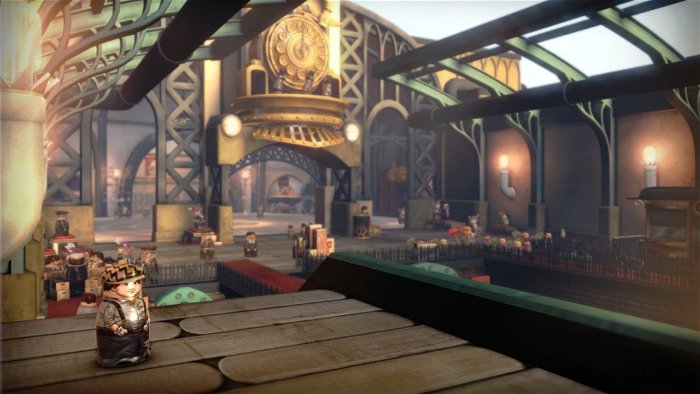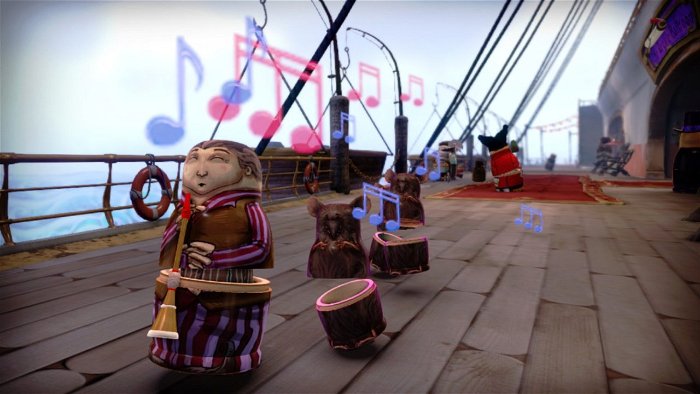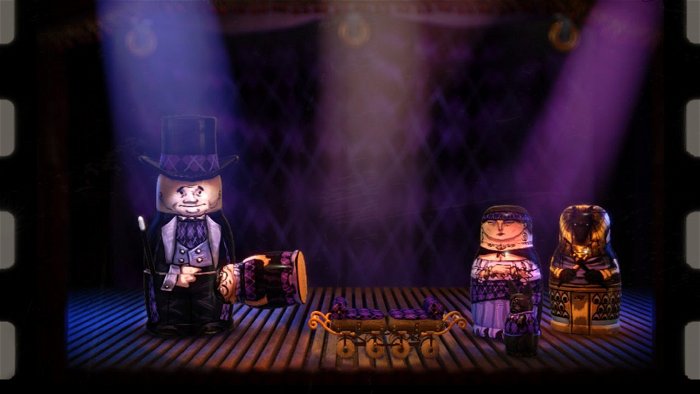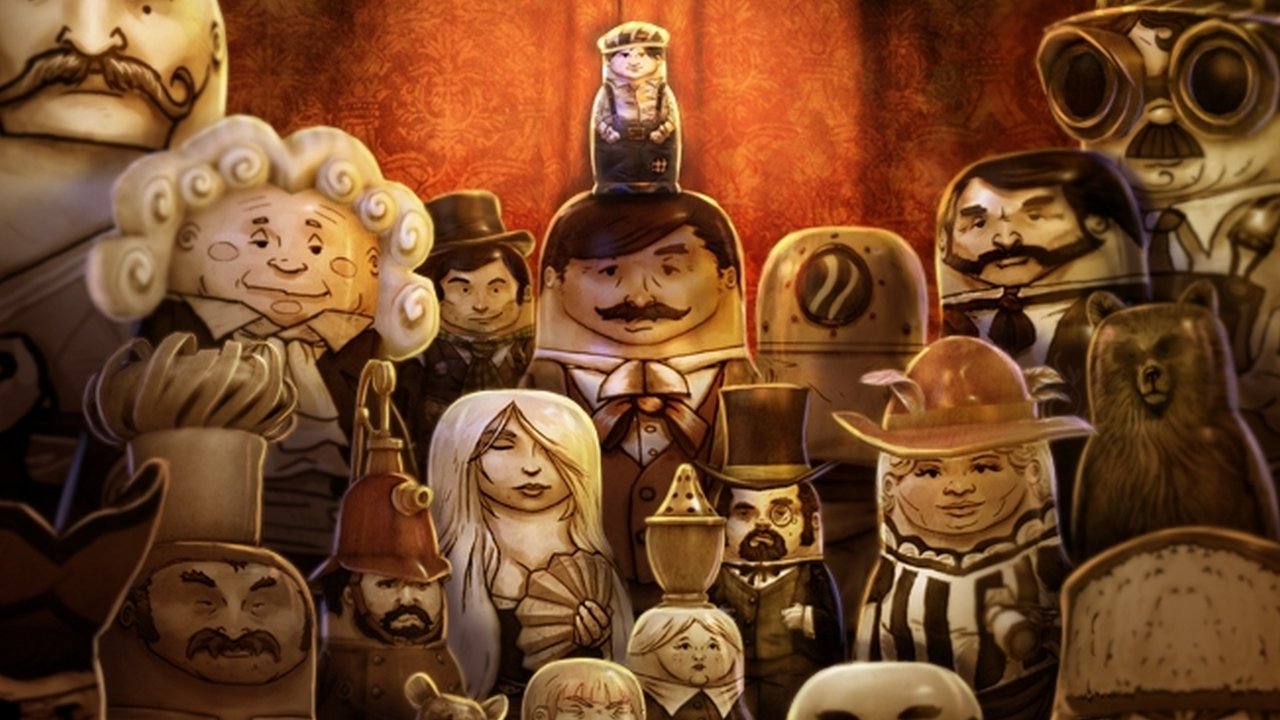If you’ve got a big bag of cash, then Lee Petty would love to make your acquaintance. The creator of Stacking says that such an artifact is crucial to the development of Psychonauts 2 and he’s currently accepting offers from any interested parties.
In the meantime, however, we’ll have to make do with Stacking. Lee Petty was kind enough to answer some of our questions about Double Fine’s latest downloadable title, so keep reading to find out more about the quirky adventures of a miniscule matryoshka.
C&G Monthly: Following Psychonauts and Costume Quest, Stacking is the third Double Fine game about abusive adults doing terrible, evil things to children, so I have to ask…what does Double Fine have against the kids?

Lee Petty: They’re short, for one. And they’re soooo not good at first person shooters.
CGM: On a more serious note, you’ve become famous for making games with a distinct brand of humor. Is there something about childhood or innocence that appeals to those comedic sensibilities?
LP: I think it’s really more about having characters that start out as a bit of an underdog and grow to become the hero over the course of the game. And in many ways, that’s a lot like the process of growing up and becoming an adult– but without erectile dysfunction.
CGM: Let’s talk about the gameplay. When (and how) did you come up with the matryoshka concept for Stacking?
LP: I came up with the idea while considering what game to prototype as part of Double Fine’s Amnesia Fortnight process, which is a two week game jam where the company is split up into small prototype teams.
I know I wanted to make a game that somehow harkened back to the old point and click adventures, but felt new. And then I saw my daughter playing with a stack of Russian dolls and I realized how interesting it could be if you could play as one of those dolls and how the act of stacking in and out of dolls would be a great moment-to-moment gameplay mechanic.
CGM: How do you go about creating a game world that makes sense for matryoshka characters? Would it have been possible to set Stacking in 2011 or 2500 instead of the 1920s?
LP: It is certainly possible, although I felt that there was a natural synergy between a turn-of-the-century aesthetic and the matryoshkas. I liked the idea of setting the world in a time of great change. The idea of rapid progress and a changing society in the industrial revolution in many ways echoes what’s going on in our world right now.
CGM: How does the silent film aesthetic complement the gameplay? Is that narrative something that emerged in tandem with the Stacking premise?

LP: I think the silent film aesthetic helped us in a number of ways. In addition to becoming the foundation for how we approached our story telling (through our silent film “stage play” cutscenes), it also let us side step dealing with dolls that talked aloud. I actually think that if the dolls had animating faces and talked aloud, they would be very creepy.
The narrative came on early in the process, but after the initial game play idea. I created several different treatments for who the player character might be, what their motivations and goals were, and ultimately what the world would teach the player. We went forward with the most grounded idea, actually.
CGM: Could you talk a bit about the puzzle design in Stacking? How do you create puzzles that challenge the player without being overly frustrating?
LP: One of our core goals with Stacking’s design was to broaden the appeal of adventure games– to make a game for more than just core gamers. But we also wanted those core gamers to want to play the game and have a lot of fun. And then the idea of multiple solutions came up. The basic idea was that the player would only have to do one solution to experience the game and move the story forward, but by making finding additional solutions convenient, we hoped to entice players who wanted more of a challenge to immediately try to find more solutions. And we reward the player who wants to do that in a number of ways, while not punishing the very casual player who just wants to move forward with the game.
CGM: It seems like the Stacking concept could be used to create a limitless number of puzzles. With that in mind, would you ever consider revisiting the idea in the future, perhaps with DLC or a full-blown sequel?
LP: Yes! We have lots of ideas! All I need is a bag of money and no questions asked.
CGM: Most of the challenges in Stacking require critical thinking instead of quick reflexes. Was that a conscious decision, or something that emerged naturally during design?
LP: It was very much a conscious decision. When we designed Stacking, we designed it with no fail conditions, no death, and no time pressure. We tried to design an experience that the player could play at their own pace, enjoying the detail in the world, and exploring all of the solutions for the challenges.
CGM: How would a more reflex-intensive Stacking game – with more obstacles like the final boss battle – differ from the game you’ve developed? Is that design space that you’d want to explore? What else can you do with the Stacking concept?

LP: There’s certainly an interesting game to be made with that approach. We had lots of ideas along that direction as well – and you see a few of them peeking through in Stacking, especially in the final sequence of the game. But I really wanted to see if we could breathe some more life into the adventure game genre. I really wanted to try and remove some of the frustration with traditional adventure games and broaden the appeal for a new generation of gamers. I also thought it would be an interesting creative challenge to try and make a game compelling that was not based on ramping a set of reflex-driven mechanics over the course of the game.
CGM: Are there any cool challenge ideas that got left on the cutting room floor, or that didn’t work as well in practice as they did on paper?
LP: Oh yeah, lots. Designing challenges for Stacking is very strange, because of the multiple solutions structure. The player can solve challenges in any order they wish, but the first solution they pick always moves the larger objective and narrative forward. This leads to some really unusual limitations that don’t exist with traditional adventure game puzzle design.
Also, we were trying to constantly surprise the player with absurd puzzles, but that were still largely logical. And that’s a pretty hard balance to achieve. What would typically happen is that we’d design a challenge with a few solutions and get it up as quickly as possible and test it. We’d add and remove solutions that would emerge as new dolls and the rest of the level developed. Usually when we removed a solution it was because it was just too illogical or could possibly be confused with one of the other solutions – which would confuse the player as to which solution they solved.
CGM: With Costume Quest and Stacking, Double Fine has been moving away from big-budget development and towards the downloadable market. How does the design of a PSN/XBLA launch differ from that of a larger AAA game?
LP: It’s quite a bit more grass roots for one. The games have smaller development budgets, and therefore smaller marketing budgets. We are still learning new ways of trying to reach the community directly. That’s why we’ve done things recently like starting a pod cast to talk about our games and the development process.
CGM: How has the new model worked for Double Fine so far? What kind of response have you gotten from the fans?
LP: It’s been great. We’ve received lots of positive responses from fans on both Costume Quest and Stacking. I think people are excited to see games come from Double Fine at a much greater rate than before, and we’re quite happy to make more games as well.

CGM: Tim Schafer has repeatedly stated that he’d like to make Psychonauts 2, but at the moment it seems to be wishful thinking. What would it take to get that title off the ground?
LP: Double Fine is an independent developer and as such needs a publisher to fund the development of a game like Psychonauts 2. So what it would take would be a publisher who’s interested in working with us to bring it to life! If anyone out there in the publishing world is reading, just send an email to Tim! Or better yet, a money hat.
CGM: Given the rapid expansion of the digital marketplace, would it ever be possible to do a bigger game like Psychonauts as a downloadable exclusive?
LP: I’d love to see the downloadable space support some bigger projects. All of us at Double Fine are very much interested in being a part of the digital marketplace and are eager to see it thrive.
CGM: Where do you see Double Fine going in the next two years?
LP: Ruling the world, one fart joke at a time.



